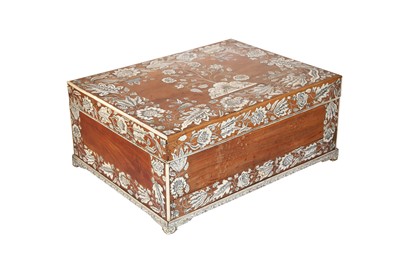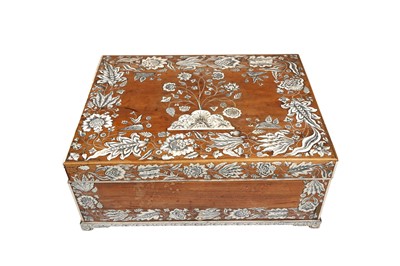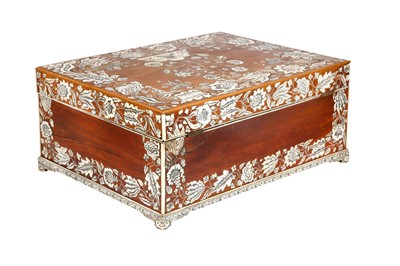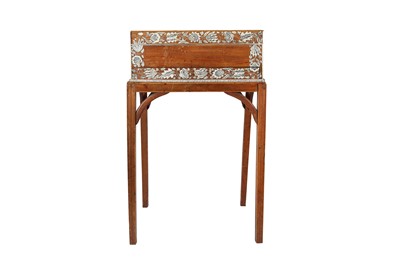29th Apr, 2022 13:00
Islamic & Indian Art
λ A LARGE ANGLO-INDIAN ROSEWOOD AND IVORY-INLAID DRESSING BOX WITH STAND
Vizagapatam, Andhra Pradesh, Eastern Coromandel Coast of India, mid-18th century
λ A LARGE ANGLO-INDIAN ROSEWOOD AND IVORY-INLAID DRESSING BOX WITH STAND
PROPERTY FROM A PRIVATE BRITISH FAMILY FROM SURREY
Vizagapatam, Andhra Pradesh, Eastern Coromandel Coast of India, mid-18th century
Of rectangular shape, resting on four ivory-inlaid bracket feet with makara motifs, surmounted by a hinged lid, featuring a single long narrow drawer on the front, the fitted sandalwood interior articulated in four square lidded compartments on the corners, pairs of smaller square recesses and two narrow rectangular compartments with lids on each side, in the middle a rectangular dressing mirror with ivory-inlaid frame and sandalwood resting legs and back support, both the interior and exterior profusely inlaid with typical Vizagapatam engraved ivory exotic flowers and foliate ornament including scrolling rosette sprays, stylised lotus flower scrolls, and serrated leaves, the lid decorated with an ivory-inlaid floral triumph featuring a central bouquet of stylised tulips, roses and marigolds stemming from a tuft of grass, framed within a large-sized decorative band of typical flora specimen from the Indian Subcontinent, the dressing box accompanied by a four-legged stand carved to fit, the dressing box 18cm x 41.5cm x 32cm, the stand 51.8cm high.
Provenance: In the collection of Miss Laura Bray, a maiden aunt of the present vendor's mother, from the early 20th century until her death in 1933;
Inherited by descent by the niece in 1933 and kept on display in her family house in Shere, Surrey, from at least 1951 to 2004; then inherited by the present vendor.
This dressing box has been treasured by a private British family for almost 100 years. The exact circumstance and date of acquisition are unclear, but what it is known is that among Bray relatives that worked in India during the British Raj, there was Hugh Bray, a cousin related to both Miss Laura Bray and the mother of the present owner, who became head of the merchants Gillanders & Co. and was a trusted member of the Viceroy’s Council. It is therefore very likely to believe that he could have purchased this dressing box in India and brought it to England as an exotica souvenir.
Among foreign officials and visitors, Vizagapatam was renowned for its cabinet-making industry which savvily combined European forms and functional designs with Indian ornamentation inspired by the local fauna and flora. From the late 17th century and the first half of the 18th century, ivory-inlaid furniture of high quality became the exclusive prerogative of senior representatives of the EIC (East India Company) and wealthy British patrons seeking exotic Anglo-Indian creations (for further reference, please see Francesca Galloway's catalogue, Ivory and Painting: Indian Goods for the Luxury Markets, 2011, cat. 2, p. 8). Local carpenters were particularly skilled at inlaying wood with a profusion of distinctive floral designs in carved and engraved ivory tesserae, which were previously highlighted with lac to increase the texture and volume of the decoration (Amin Jaffer, Furniture from British India and Ceylon, 2001, pp. 172 - 175). The ivory ornamentation frequently featured a standard repertoire of scrolling leafy stems, exotic flowers and ribbon arrangements, resembling locally-produced painted cotton panels (chintz), which were also sought after in the European export market.
Several dressing boxes similar to ours have been successfully sold in the London auction market in the last 10 - 15 years, including Sotheby's London, 5 June 2007, lot 175, and Christie's London, 21 May 2015, lots 70 and 71. Our lot shows an almost identical decorative programme to Christie's lot 70 on each and every side. The only minor difference is found on the floral band on the edge of the lid, where a stylised lotus and a frilled tulip have been inverted in the arrangement, indicating that despite the standardisation of motifs there was still 'room for mistakes' and independent characterisation of the piece by the artists.
This item may require Export or CITES licences in order to leave the UK or the European Union. It is the buyer's responsibility to ensure that lots have the relevant licences before shipping.
Sold for £4,000
Includes Buyer's Premium
Do you have an item similar to the item above? If so please click the link below to submit a free online valuation request through our website.






